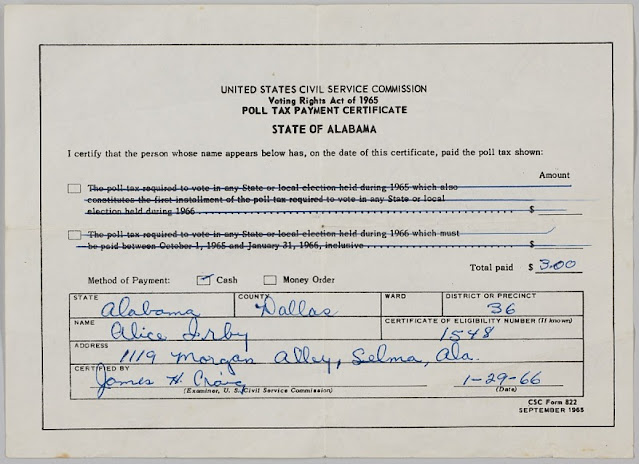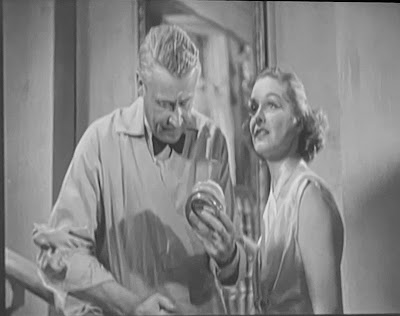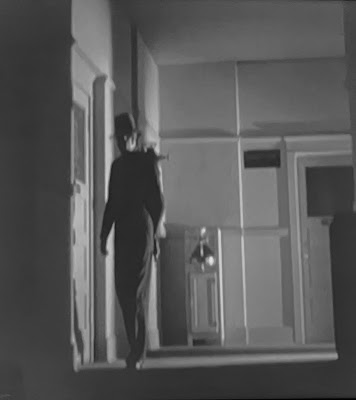Friday, October 27, 2023
A 1936 Check from Marion Bank & Trust
Friday, October 20, 2023
Lola Montez Visits Mobile in 1852
Lola Montez in 1851
In the first half of the nineteenth century "Lola Montez" was a famous--and notorious--dancer and actress who performed in Europe, the United States and elsewhere. She was born in Ireland on February 17, 1821, as Eliza Rosanna Gilbert. At the age of 16 she eloped to India with Thomas James, a lieutenant who became her first husband. They separated five years later, and Gilbert began her professional dancing career as Lola Montez.
In her short life Montez would have two other husbands and numerous lovers. That group included King Ludwig I of Bavaria, who gave her the title Countess of Landsfeld. In 1848 revolutions began in the German states, and Montez fled for Austria, Switzerland, France, London, and then America. She supported herself by dancing as she had earlier under the name Lola Montez.
Her career declined in the later 1850s. After a failed tour of Australia in 1855 and 1856, she returned to the U.S. by way of San Francisco. Further U.S. tours were unsuccessful, and she spent her final years in rescue work among "fallen" women and lecturing on morality. Montez died of syphilis on January 17, 1861, a month short of her 40th birthday, and was buried in Green-Wood Cemetery in Brooklyn, New York.
At the height of her fame she descended upon Mobile in December 1852. The Port City was not very large at the time, but had a lively performing arts scene and was a perfect stop for entertainers or theatrical companies appearing on tour in Charleston, South Carolina and New Orleans. Thus Mobile attracted Montez after appearances in Charleston that year.
Her venue was the Mobile Theatre, opened in 1841 and being operated at that time by Joseph Field, an actor, writer and theatrical manager. I've written about one of his publications, The Drama in Pokerville [1847], some of which is set in Wetumpka. Local newspapers expressed some trepidation about the appearance of Montez, but her visit was also highly anticipated. The Mobile Daily Register declared that "...the terror of the Jesuits, the favorite of an Emperor, and the cynosure of all eyes; will make her appearance on the Mobile state tomorrow evening...already we are impatient." Because of her lifestyle and her for-the-times erotic dancing, Montez was a controversial figure, but that didn't seem to prevent many people from attending her performances.
The arrival of Montez by the steamer Louisa was delayed, which no doubt increased the local anticipation. She gave six performances from December 21 and 28. Despite selling out the theater, Montez and Field had entertainment competition in Mobile. Horse races continued at the Trotting Club and Dan Rice's Hippodrome featured minstrel shows, circus acts and a parody of Hamlet.
The December 21 crowd included "a large number of highly enthusiastic ladies" who watched Montez in her "Sailor's Dance" and "Spider Dance". These performances came between various comedies from the theater's regular company. After two night of dances, a third night on December 23 featured "Lola Montez in Bavaria" with the lady enacting scenes from her own life. Christmas Eve repeated the drama, but added "Sailor's Dance".
On Christmas Day she played the title role in Maritana with Joseph Field as the male lead. Maritana was an opera written by William Vincent Wallace and first performed in London in 1845. Her final appearance on December 28 repeated "Lola Montez in Bavaria" and added the dance "La Saviglliana". On that final night the enthusiastic audience convinced her to repeat the dance. In a curtain call Montez expressed her appreciation of the response to her by audiences in Mobile. She left the city and arrived in New Orleans on New Year's Eve.
I want to express my appreciation to Sara Elizabeth Gotcher whose dissertation cited below provided many details and newspaper quotes about Montez's appearance in Mobile.
FURTHER READING
Burr, C. Chauncey. Autobiography of and Lectures by Lola Montez [1860]
Gotcher, Sara Elizabeth. "The Career of Lola Montez in the American Theatre" PhD dissertation, LSU, 1994
Morton, James, Lola Montez: Her Life & Conquests, Portrait, 2007
Seymour, Bruce, Lola Montez, a Life, Yale University Press, 1996
Photo by Antoine Samuel Adam-Salomon
Thursday, October 12, 2023
Alabama River at Selma on a 1907 Postcard
Now we come to a post on one of my favorite topics, old postcards. I've written one piece on a number from my own collection, "Some Old Alabama Postcards (1)". I really must move on to part two one of these days. I've also incorporated postcards into a number of entries on this blog, such as the one on "Carnegie Libraries in Alabama."
I've found many interesting cards, such as the one below, at the Alabama Mosaic collection of digital resources from various libraries in the state. You can browse through more than 8200 here.
So what's up with this postcard? First, it was issued by the Rotograph Company, founded in New York City in 1904. The company closed in 1911, but not before it had printed cards with numerous images from around the U.S.
This card has a view of the Alabama River passing through Selma, with a bridge in the foreground constructed in 1885 by the Milwaukee Bridge and Iron Works. Another postcard below shows the draw bridge open for river traffic. This structure was replaced by the Edmund Pettus Bridge in 1940.
The address side of the card tells us it was sent to Miss Zola Campbell of Darlington, Indiana. Via Ancestry.com and Find-A-Grave I located a Zola Campbell who died in 1960 aged 78 and is buried in Darlington. Various entries for her in the U.S. census track her through the years in Indiana; she never married. In 1950 she was living with another single woman two years younger on Main Street in Darlington and working as a library assistant. The 1940 census gives the same information, except she is a "Senior Library Clerk."
The postmark is unreadable, but the sender has conveniently written a date, August 21, 1907, on the front of the card along with his message. The one-cent Ben Franklin stamp used here was first issued in 1902.
So what is our correspondent's message on this postcard? He [presumably] informs Zola that "Haven't seen or heard of any of our party so far" and puts those words in parentheses. Also set off that way is "Used to swim here" either under or near the bridge. Does that mean he grew up in Selma? Visited relatives there?
Finally, at the bottom of this side of the card is "Now wont [sic] you be good? Been fishing up the State and am headed for Texas. Had great time. Write me. With love [what may be] Mom and Dad. If that last part is correct, the card may have been written by her father, Thomas M. Campbell, who was also born in Indiana. Perhaps the "our" is himself and his wife, Zola's mother.
Except for the swimming and fishing notations, much of this message is cryptic to us. What "party" is he expecting to see or hear from? Why does he ask Zola about being good? By 1907 she was 26 years old. What is the background of the note "Used to swim here"?
Zola Campbell's obituary can be seen below. Since she lived in a small town and died in 1960, and had a sister that survived her, I wonder if anyone in Darlington today could offer some clues.
I presume the "B5-PC 4.50 1907" notation in pencil was added by a dealer in such ephemera.
Ah, the mysteries of postcard messages more than a hundred years old....
Source: Alabama Dept of Archives and History
Friday, October 6, 2023
Back in the Days of the Poll Tax
As one does in these days of modern times, I recently wandered through the online riches at the Smithsonian Institution web pages. The Alabama resources there are numerous, and this time I came across the poll tax payment certificate seen below.
Along with literacy tests, property or residency requirements, U.S. poll taxes were one of the methods used to prevent African Americans from voting beginning in the last quarter of the 19th century. After the Fifteenth Amendment enabled the right to vote for African Americans, a number of states enacted poll tax laws as a legal method to restrict voting rights. The poll tax was especially effective in disenfranchising potential black voters since African Americans made up a disproportionate number of the poor who could not afford to pay. Of course, a number of poor whites were also affected.
This certificate is evidence that Alice Irby, a resident of Selma, paid the tax on January 29, 1966. An examiner from the U.S. Civil Service Commission certified the document. Voter registration for blacks in Dallas County had been problematic for decades. In 1958 the Commission met in Montgomery and took testimony about problems faced by blacks trying to register to vote in the state. At that time 130 of 15,115 eligible blacks in Dallas County were registered.
In going through mom's house in Huntsville, my brother Richard and I have recently discovered five family documents that are related to this topic. See them below with comments.
Friday, September 29, 2023
Birmingham's Hillman Hospital Opens in 1903
In July 2014 I posted an item on this blog, "Hillman Hospital and How It Became UAB." I recently came across the article below published in the May 3, 1903, issue of the Birmingham Post-Herald just before Hillman opened. The piece is full of fascinating details about this early city hospital, which replaced a 100-bed facility that had burned in 1894. Various temporary quarters were used until Hillman opened for paying patients on June 16, 1903, the day after a reception for local visitors.
Groundbreaking ceremonies had taken place on May 2, 1902; a year was required to build the facility. The article declares medical advances "make the hospital one of the great institutions of today...The charity hospital is in a class alone. No other philanthropic institution is comparable to it. The Hillman hospital is a charity hospital" and will be to Birmingham what Bellevue is in New York." Birmingham Medical College, which had opened a new building next door, provided most of the hospital's medical staff.
About $60,000 was spent to build the hospital, which was four stories high of red brick and white stone. The building was fireproof and heated by steam; it featured electrical elevators, gas and electricity lighting and steam heat. The interior finish was native pine, and the bathroom and operating room floors were Venetian mosaic. Hillman had room for about 98 patients.
The basement held clinics, dispensary, physician offices, laboratories, the laundry, various storerooms, and the boiler and fuel room. On the first floor were the nurse superintendent and resident physician offices, reception room, six private rooms, and two large wards. Six more private rooms, two more adult wards and a large children's room with sunlight and toys were located on the second floor.
On the third floor could be found the surgical amphitheater with seating for 80 students, a private operating room and sterilization and anesthesia rooms. Also located there were five more private rooms and two wards for surgical patients. The top floor had a kitchen with dumb waiter connection to the other floors. Also found there was a dining room, nurse's dormitory and six private rooms.
The article includes extensive quotes from the newly-hired superintendent of nurses at Hillman, Miss Nannie Boyce Hamilton, "one of the best equipped young women in the profession. She has diplomas from the famous hospitals of the north, and to her experience and training she adds a wonderful executive and business ability. she is a very remarkable young woman."
Miss Hamilton praised the plainness of Hillman Hospital furnishing which mad cleanliness much easier, "affording no lurking place for dust." She notes the presence of a study and sitting room for nurses' use in their time free from patient care or classes. Hamilton hoped to establish a nurses' library, and pointed to the amphitheater, private operating rooms and large children's ward as important features.
Hillman was a charity hospital, but did take paying patients who were the ones able to afford private rooms. Four graduate nurses and eight student nurses cared for those private patients. Hillman Training School for Nurses graduated seven students in 1903.
All of these wonderful facilities and staff did not prevent financial problems that Hillman soon developed. By May 1907 Jefferson County agreed to assume the outstanding $9000 debt on the property, and under it's control the hospital continued to admit charity patients.
I did a bit of research on Annie Kendrick Walker and Nannie Boyce Hamilton, but found very little. Walker did publish two family histories, Memoirs of the Graham Family [1908] and Old Shorter Houses and Gardens [1911]. On March 24, 1900, she had published a profile of popular novelist Mary Johnston in the New York Times; Johnston lived for a period Birmingham.
Hamilton did not remain at Hillman for too many years. The Holley book cited below notes that the nursing superintendent at Hillman, a different woman, remained in that position in 1907 when Jefferson County took over.
Further Reading
Holley, Howard L. A History of Medicine in Alabama [1982]
Holmes, Jack D.L. A History of the University of Alabama Hospital [1974]
Wright AJ. Hillman Hospital. Hektoen International spring 2015
Source: Views of Birmingham, 1908
Thursday, September 21, 2023
Johnny Mack Brown as Billy the Kid
I recently picked up and flipped through my copy of William K. Everson's classic A Pictorial History of the Western Film, as one does when escaping the heat of an Alabama summer day. What did I find but a couple of stills and some discussion of Johnny Mack Brown's role as William Bonney in the 1930 film Billy the Kid. Let's investigate.
Friday, September 15, 2023
Gail Patrick in "The Preview Murder Mystery"
One of the topics I bring out from time to time on this blog is film actresses from the state whose careers began before 1960. I've covered some others after that date, too, but today's post fits that group.
One of those pre-1960 actresses is Birmingham native Gail Patrick. A career overview I posted in 2015 is here. In 2019 I wrote about her role as a private detective [really!] in Murder at the Vanities, a truly bonkers 1934 pre-code film. In 2020 I posted about her post-acting career as Executive Producer on the classic Perry Mason TV series and her appearance in the final episode. In 2021 I wrote about her role as the femme fatale in The Maltese Falcon--a radio version, but still....
Now we come to her role in The Preview Murder Mystery from 1936. I watched this one recently on TCM and really enjoyed it. There's a rather interesting framing device--it's a movie about the making of a movie and features quick action, witty dialog and some murders. Director Robert Florey would helm over 50 movies and numerous episodes of TV shows in his long career. By the time he made this one, he had already directed such classics as the Marx Brothers first feature, The Cocoanuts [1929] and Murders in the Rue Morgue [1932].
The film being filmed is "Song of the Toreador", and we get to see some extensive scenes in its preview screening. We also see even longer scenes involving the filming process, so that the cast and crew of "Toreador" are much of the cast and crew of Preview. Very meta. "Song" is a remake of a silent film starring the late husband of Patrick's character, Claire Woodward Smith.
A lot of this film's snap, crackle and pop is courtesy of the performances by and dialog written for Reginald Denny and Frances Drake as they play the studio publicity head and his secretary. A running gag is Denny's constant proposals of marriage, and refusals by Drake, whose character is an astrology nut and keeps telling him the stars are not aligned properly.
Catch this movie if you have a chance. It's only an hour long and is available on YouTube.
Some more comments are below.






















































